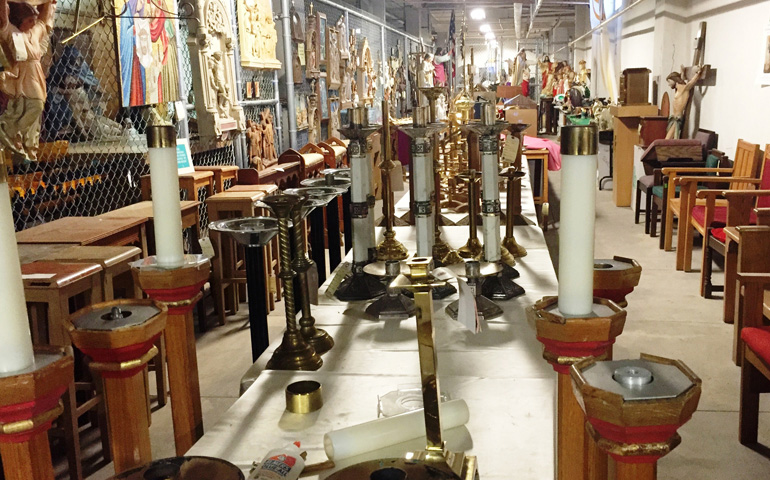
Rows of goods at the Ecclesiastical Exchange at St. Charles Borromeo Seminary in Philadelphia (Menachem Wecker)
On the first Wednesday morning of December, Fr. Jason Kulczynski brought an unusual shopping list to St. Charles Borromeo Seminary here. Two weeks prior, his congregation, Holy Martyrs Catholic Church in Oreland, Pa., installed the altar Pope Francis had used in a September Mass in Philadelphia. Using it for the first time, Kulczynski was struck that the most recent, and only, person to offer Mass at the altar had been the pope. "That was very awesome," he said.
With Christmas looming, Kulczynski sought an altar cloth to adorn his parish's famous new addition, which was a "shot in the arm," as the church had recently been in danger of shuttering.
He wound up spending $100 that day on a picture, a stole and several altar cloths, including two traditional white ones with embroidered edges that he hopes will fit the papal altar.
Kulczynski was one of about a dozen people -- a handful clad in clerical collars -- shopping for sacred objects at the Philadelphia archdiocese's Ecclesiastical Exchange. Launched in 1992, the program has sold unused religious objects at a steep discount to churches in Pennsylvania, as well as in Arizona, Florida, New York, Oklahoma, Oregon, South Carolina and Texas.
"It's like going to the dollar store or a church flea market; you find more things than you're looking for," Kulczynski said.
The warehouse-style setting in the seminary basement contains thousands of objects, such as an Israeli flag, a small bell ($1), a wooden clapper ($5), a table of small crucifixes ranging from $1 to $5, vestments, a framed print of Salvador Dali's 1951 "Christ of St. John of the Cross" ($80), and a shelf of chalices ranging from $20 to $30.
A nearby sign states, "Chalices and ciborium can only be acquired by members of the Catholic clergy."
On the costlier side, a monstrance can set a church back $3,000, and a 14-piece Stations of the Cross costs the same amount. A Nativity set in a different corner bears a price tag of $1,500.
The objects are arranged on tables, hung on chain-link fencing, displayed on shelves, and in the case of clothing, dangled from hangers.
The very high end would be an entire stained glass window; if a church took all of a closing parish's windows, that could cost $150,000.
In a back room, a white marble altar set came from the chapel at St. Mary's Villa for Children and Families in Ambler, Pa., where "The Trouble with Angels" (1966) was filmed. This reporter arrived envisioning a different movie set -- the final "Raiders of the Lost Ark" scene -- and found some of the mustiness, none of the scale (nor the Old Testament golden treasure), and a bit of the organized chaos.
Ed Rafferty, who coordinates the archdiocese's Ecclesiastical Exchange Office, admitted that purchasers need to come with vision. "The objects are a little broken here, chipped there, and tarnished there," he said. "You have to see a little bit beyond that to what the potential is."
Msgr. Louis D'Addezio, who directed the exchange from 1992 until his retirement six years ago, can't even hazard a guess at the "astronomical" number of objects that have passed through the exchange. Over a decade ago, a report estimated a "collective gross something like $5 million," said D'Addezio, who now serves as a consultant for the program. "God knows what it is now."
Cardinal Anthony Bevilacqua, then archbishop of Philadelphia, created the office in 1992, ahead of the closings of several parishes.
"He said, 'Lou, I want you to establish an office, because there are going to be closures, and I don't want things -- as have been in the past -- ending up either in antique shops, restaurants or people's homes,' " D'Addezio said.
The exchange, D'Addezio said, was the first of its kind, and representatives from dioceses in New Jersey and New York have come seeking guidance on how to replicate its success. The objects only get sold to Catholic churches, except in rare circumstances.
"If it's high Episcopalian and we know them somewhat, an exception may be made for them to purchase maybe some candlesticks," D'Addezio said. "That's about it."
When a church in the diocese closes, other churches in the diocese get first dibs on objects with Catholic identity. If a church wants what D'Addezio called "movables," it purchases and removes the objects on the spot.
That afternoon, the on-site sale at the closing church opens to other dioceses; buyers come from Delaware, New Jersey and elsewhere, D'Addezio said.
Objects that don't get sold on site then come to the exchange, which also receives objects that churches in operation don't use. (It's gone both ways for Kulczynski, who said that some of the objects from his church that weren't being used are now for sale at the exchange.)
The Philadelphia archdiocese takes a 10 percent cut of the sales to cover administrative expenses and rent, according to D'Addezio.
"None of the monies that we receive from these [sales] goes into the treasury of the archdiocese of Philadelphia," he said. If two churches are closing and being incorporated into a third, that third church would receive the proceeds; if a church is selling unused objects, it receives 90 percent of the sale.
Not only is a walk through the exchange an exercise in navigating a dizzying array of colors and shapes, but it's also bittersweet. Although the objects are destined for new homes -- for lives after death, in a way -- they are in the seminary basement because they outlived their use to their former owners.
"I think I got over that earlier on," said Rafferty, of the sad feeling. "It's something that has to be done. This is the best thing out of a tough situation."
Through the exchange, Kulczynski's church acquired a shrine to St. Thérèse of Lisieux that had a Slovak inscription of the saint's name installed above her statue. Knowing how hard it must have been for the congregation of the closing church, he assured the sexton that the inscription would remain in its new installation as a memorial.
"It's a bittersweet thing," he said. "In the past, a lot of these things would have ended up in the hands of antiques dealers and thrift shops. These sacred things really ought to be preserved as sacred things."
Kulczynski has seen chalices and ciboria in antique shops and even in flea markets. When he sees them on eBay, he buys them if he can afford it, as he did with a chalice that touched him for its inscription on the bottom identifying it as a gift from someone's mother and father.
"I thought now this metal dealer is selling it for the price of the silver," he said. "We have the opportunity to take these things and keep them in sacred use."
Rafferty, who has worked at the archdiocese for 15 years, draws upon his background as a professional watercolor artist of 20 years when he handles the objects. He's noticed a "style shift" in the kinds of work that people want to buy, which he credits to increasing interest in the Latin and Tridentine Mass.
Traditional works tend to leave shelves sooner, he said. "Some of the really contemporary items from the 1950s and 1960s can be very hard to place sometimes."
D'Addezio, who is blunt about his distaste for modern art, has seen a similar shift.
"In the 1960s and early 1970s, everything was modern. Everything was plastic and straight and so on. The pendulum has completely turned," he said. "People are looking now for artistic things that are Baroque, that were pre-Vatican II. People thought that Vatican II said get rid of them, which it didn't say. There is a great tendency now to have a more artistic approach to things that we place in churches."
[Menachem Wecker is co-author of the book Consider No Evil: Two Faith Traditions and the Problem of Academic Freedom in Religious Higher Education.]




